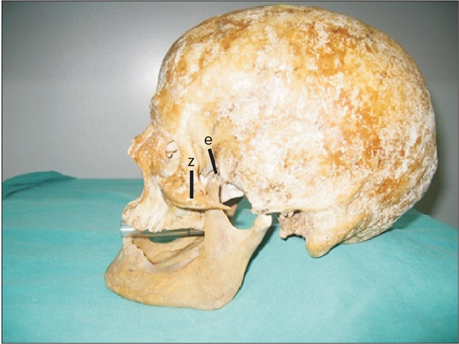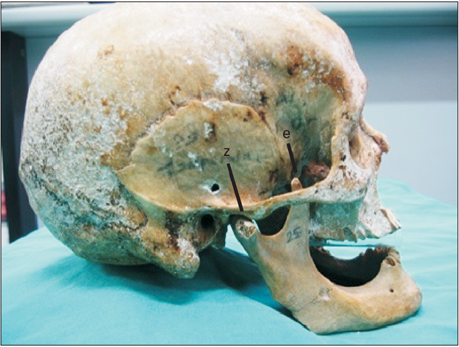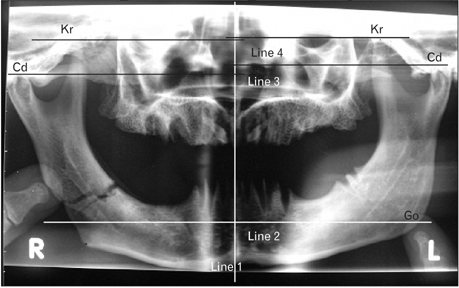Anat Cell Biol.
2016 Sep;49(3):217-220. 10.5115/acb.2016.49.3.217.
Bilateral elongated mandibular coronoid process in an Anatolian skull
- Affiliations
-
- 1Government of Health, 112 Emergency Service, Medical Practitioner, Samsun, Turkey.
- 2Department of Anatomy, Medical Faculty, Ondokuz Mayıs University, Samsun, Turkey. drkopuz@gmail.com
- 3Government of Health, Hospital of Education and Investigation, Emergency Clinics, Samsun, Turkey.
- KMID: 2353349
- DOI: http://doi.org/10.5115/acb.2016.49.3.217
Abstract
- Elongation or hyperplasia of coronoid process of mandible is rare condition characterized by abnormal bone development which cause malocclusion and the limited mouth opening. In this study, in an Anatolian skull, a case of bilateral elongation of mandibular coronoid process was presented. Levandoski panographic analysis was performed on the panoramic radiographie to determine the hyperplasia of the coronoid process. The right condylar process was exactly hyperplastic. The measurements of Kr-Go/Cd-Go were 95.10 mm/79.03 mm on right side and 97.53 mm/87.80 mm on left side. The ratio of Kr-Go/Cd-Go on the right side was 1.20. Elongated coronoid process is one of the factors cause mandibular hypomobility, it as reported here might lead to limited mouth opening. The knowledge of this variation or abnormality can be useful for the radiologist and surgeons and prevent misdiagnosis.
Keyword
MeSH Terms
Figure
Reference
-
1. Standring S. Gray's anatomy: the anatomical basis of clinical practice. 40th ed. Edinburg: Churchill & Livingstone;2008. p. 530–532.2. Hönig JF, Merten HA, Halling F, Korth OE. An X-ray study of the incidence of asymptomatic hypertrophy of the coronoid process. Schweiz Monatsschr Zahnmed. 1993; 103:281–284.3. Lucaya J, Herrera M, Vera J. Unilateral hyperplasia of the coronoid process in a child: a cause of restricted opening of the mouth. Radiology. 1982; 144:528.4. Mulder CH, Kalaykova SI, Gortzak RA. Coronoid process hyperplasia: a systematic review of the literature from 1995. Int J Oral Maxillofac Surg. 2012; 41:1483–1489.5. Pregarz M, Fugazzola C, Consolo U, Andreis IA, Beltramello A, Gotte P. Computed tomography and magnetic resonance imaging in the management of coronoid process hyperplasia: review of five cases. Dentomaxillofac Radiol. 1998; 27:215–220.6. McLoughlin PM, Hopper C, Bowley NB. Hyperplasia of the mandibular coronoid process: an analysis of 31 cases and a review of the literature. J Oral Maxillofac Surg. 1995; 53:250–255.7. Gibbons AJ. Case report: computed tomography in the investigation of bilateral mandibular coronoid hyperplasia. Br J Radiol. 1995; 68:531–533.8. Capote A, Rodríguez FJ, Blasco A, Muñoz MF. Jacob's disease associated with temporomandibular joint dysfunction: a case report. Med Oral Patol Oral Cir Bucal. 2005; 10:210–214.9. Munk PL, Helms CA. Coronoid process hyperplasia: CT studies. Radiology. 1989; 171:783–784.10. Zhong SC, Xu ZJ, Zhang ZG, Zheng YH, Li TX, Su K. Bilateral coronoid hyperplasia (Jacob disease on right and elongation on left): report of a case and literature review. Oral Surg Oral Med Oral Pathol Oral Radiol Endod. 2009; 107:e64–e67.11. Costa YM, Porporatti AL, Stuginski-Barbosa J, Cassano DS, Bonjardim LR, Conti PC. Coronoid process hyperplasia: an unusual cause of mandibular hypomobility. Braz Dent J. 2012; 23:252–255.12. Ilguy M, Kursoglu P, Ilguy D. Three cases of elongated mandibular coronoid process with different presentations. Iran J Radiol. 2014; 11:e4031.13. Kubota Y, Takenoshita Y, Takamori K, Kanamoto M, Shirasuna K. Levandoski panographic analysis in the diagnosis of hyperplasia of the coronoid process. Br J Oral Maxillofac Surg. 1999; 37:409–411.14. Izumi M, Isobe M, Toyama M, Ariji Y, Gotoh M, Naitoh M, Kurita K, Ariji E. Computed tomographic features of bilateral coronoid process hyperplasia with special emphasis on patients without interference between the process and the zygomatic bone. Oral Surg Oral Med Oral Pathol Oral Radiol Endod. 2005; 99:93–100.15. Javid B. Unilateral hyperplasia of the coronoid process of the mandible: case report. Int J Oral Surg. 1981; 10:145–147.16. Chauhan P, Dixit SG. Bilateral elongated coronoid processes of mandible. Int J Anat Var. 2011; 4:25–27.17. El-Labban NG, Harris M, Hopper C, Barber P. Amianthoid fibres in muscle tissue associated with temporomandibular joint ankylosis. Ultrastruct Pathol. 1986; 10:571–576.18. Charrier JB, Creuzet S. Embryology of the face and oto-mandibular dysplasia. Orthod Fr. 2007; 78:7–24.19. Lee SK, Kim YS, Oh HS, Yang KH, Kim EC, Chi JG. Prenatal development of the human mandible. Anat Rec. 2001; 263:314–325.20. Bareggi R, Sandrucci MA, Baldini G, Grill V, Zweyer M, Narducci P. Mandibular growth rates in human fetal development. Arch Oral Biol. 1995; 40:119–125.21. Atchley WR, Hall BK. A model for development and evoluation of complex morphological structures. Biol Rev Camb Philos Soc. 1991; 66:101–157.22. Fernández Ferro M, Fernández Sanromán J, Sandoval Gutierrez J, Costas López A, López de Sánchez A, Etayo Pérez A. Treatment of bilateral hyperplasia of the coronoid process of the mandible. Presentation of a case and review of the literature. Med Oral Patol Oral Cir Bucal. 2008; 13:E595–E598.23. Isberg A, Isacsson G, Nah KS. Mandibular coronoid process locking: a prospective study of frequency and association with internal derangement of the temporomandibular joint. Oral Surg Oral Med Oral Pathol. 1987; 63:275–279.24. Kursoglu P, Capa N. Elongated mandibular coronoid process as a cause of mandibular hypomobility. Cranio. 2006; 24:213–216.
- Full Text Links
- Actions
-
Cited
- CITED
-
- Close
- Share
- Similar articles
-
- Severe trismus due to bilateral coronoid process hyperplasia in growth hormone therapy patient: a case report
- Coronoid impingement syndrome: literature review and clinical management
- Coronoid Process Hyperplasia: A Rare Case of Restricted Mouth Opening Masquerading as Temporomandibular Disorder
- Reconstruction of the coronoid process using a graft from the olecranon of the same side for chronic posterior dislocation of the elbow
- Trismus Due to Bilateral Coronoid Hyperplasia




